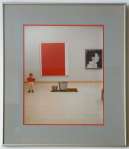 As largely documented in the Interface Painting essays, life is made up of opposites and their point of interface seems to be a pivot between them, one that is responsible for the unseizable, undefinable dynamic that makes us human. Along with this dynamic, the essays speak of the basic human desire that seems to be the crux of his psyche, that being the desire to transcend, to transcend his isolated nature as an individual and his limited capacity for knowing himself.
As largely documented in the Interface Painting essays, life is made up of opposites and their point of interface seems to be a pivot between them, one that is responsible for the unseizable, undefinable dynamic that makes us human. Along with this dynamic, the essays speak of the basic human desire that seems to be the crux of his psyche, that being the desire to transcend, to transcend his isolated nature as an individual and his limited capacity for knowing himself.
I have always wanted my work to achieve a truly human form and I feel that the above characteristics are fundamental to it. In my mind, they are its core incarnated.
Because of this, my present work, that following the Interface Painting series, revolves around the following question: How can I pictorially build upon that which I have already done? How can I continue to express these human concerns—what I consider to be fundamental and final—in other visual forms, and hopefully ones even more interesting, while still preserving what I consider to be the absolute qualities of my past work, that is to say, the qualities that should be present in any work worthy of the term artwork.
You Know, and I Know, What Life’s About
 2012
2012
Dimensions: 58 by 87 cm, including nail and canvas strip.
Media: Paint on wood panel, and canvas. Painted cardboard, nail.
All the many details, mentioned below, their complex symmetry and harmony, are conceived to create a visual concept worthy of the attention ellicited by the text. A fine balance between “Less is more” and “More is more” is critical. To Note: We’re dealing in visual art here and one should not use text in his visual art to try to make up for the lack of interest in the visuals.
That old nail at the top left is one of the ancient types. It tacks on the strip of painted white canvas that ensures the necessary balance in respect to the strip of white paint that runs down the middle of the work and then runs to the right of it. As importantly, the nail provides the texture and form to ensure the balance with the letters dug into the wood panel. Along with this play of symmetry, a small white square on the wood panel, and another more discrete one on the white canvas part of the work, provides another facet of symmetry, and leads the eye towards the painted cardboard sheet at the center of the white canvas. Penciled right angles in agreement with the dimensions of the white squares and the corners of the canvas’ frame are also used, one under the white square on the wood panel, and others at the corners of the canvas’ frame. The green paint splatches lead down towards the signature L to the bottom right of the work. These splatches have a graphic look to compliment the lettering dug into the wood, and their color, green, was chosen for its natural relationship to wood. Emphasis is given to YOU and I with black paint, the YOU underlined and the I simply painted black. Not only do these graphic tricks give emphasis to the words You and I but they compliment, create a necessary symmetry with, the black lines shadowing the painted cardboard sheet at center right.

